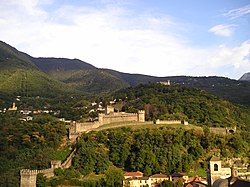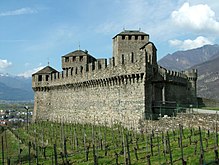Bellinzona castles
| Bellinzona castles | |
|---|---|
|
UNESCO world heritage |
|

|
|
| Castello di Montebello and Castello di Sasso Corbaro (above) as well as parts of the Murata |
|
| National territory: |
|
| Type: | Culture |
| Criteria : | (iv) |
| Reference No .: | 884 |
| UNESCO region : | Europe and North America |
| History of enrollment | |
| Enrollment: | 2000 (session 24) |
The three castles of Bellinzona ( Castelli di Bellinzona in Italian ) are a fortification in Bellinzona , the capital of the canton of Ticino in Switzerland . The facility in its current form was mainly built in the 15th century as a dam and to control the access routes to the Alpine passes. It consists of the three castles Castelgrande , Castello di Montebello and Castello di Sasso Corbaro as well as the city wall and the Murata defensive wall. Since 2000, the castles along with Murata is a world heritage of UNESCO .
Strategic importance
The castles are strategically located in an extremely favorable position. Several important pass routes converge in the Ticino valley . In modern times these are the Gotthard , the San Bernardino , the Lukmanier and the Nufenen , in earlier centuries mule tracks also led over the Greina and San Jorio . At Bellinzona, these routes combine to form a strand just a few kilometers long. A mighty rock ridge protruding into the river level leaves only two passages open. While the Castelgrande towers over the old town, Montebello and Sasso Corbaro are on the eastern side of the valley on ledges. Together with the Murata and the city wall, the valley could be completely sealed off. The Milanese commissioner Azzo Visconti described the strategic location as follows in 1475: "This square is the key and gateway to Italy" (Questa terra è pur una giave e porta de Italia) .
history
Grave fields and individual building remains document a continuous settlement of the area around Bellinzona since the 4th millennium BC. The prehistoric finds concentrate on the castle hill of Castelgrande. During the reign of Emperor Augustus , the Romans conquered in 16/15 BC. The Alpine region as part of the Augustan Alpine campaigns . To protect themselves, they built a fort on the rocky hill of Castelgrande . This was abandoned in the course of the 1st century AD and rebuilt in the middle of the 4th century. In 457 an Alemannic army was pushed back on the northern plain of Arbedo .
After the collapse of the Western Roman Empire , the Ostrogoths took control of the area around Bellinzona from around 500, and the Byzantine Empire , which had grown stronger in the meantime, followed in the middle of the 6th century , and the Lombards ruled from 568/70 . Each of these successor states used the Castelgrande as a means of developing power in the region. Gregory of Tours reports a Frankish attack in 590 that the Lombards were able to repel. In 774 Bellinzona came to the Franconian Empire . In the early Middle Ages, the Castelgrande continued to serve as a military base, and in times of war it also served as a refuge for the population in the area. Margrave Arduin von Ivrea was elected King of Italy in 1002 and confirmed Bellinzona as the property of the Diocese of Como . Two years later, after Arduin's expulsion, the German King Heinrich II renewed this confirmation.


During the investiture controversy , Bellinzona and the castle were under the control of the Hohenstaufen . In 1180, Emperor Friedrich I transferred ownership to the city of Como . After the Gotthard Pass had been expanded at the beginning of the 13th century, the strategic importance of Bellinzona grew and the place got into the conflict between Ghibellines and Guelphs . In 1239 Como joined the Ghibellines, loyal to the emperor. But as early as 1242, the Guelf city of Milan managed to conquer Bellinzona. The city changed hands several times (1284, 1292, 1303). In the late 13th century, the noble Rusca family from Como had the Castello di Montebello built. In 1335 Como was conquered by Milan and the Rusca had to retreat to Bellinzona. In 1340 Bellinzona also fell to the Visconti from Milan.
In 1402, after the death of Gian Galeazzo Visconti, unrest broke out in the Duchy of Milan . The barons of Sax from the neighboring Misox valley took advantage of the unsafe situation and took Bellinzona into their possession in 1403. In 1419 they sold the town and castles to the federal estates of Uri and Obwalden , which had expanded into the Leventina . When the Confederates did not accept the repurchase offer, the Milanese recaptured Bellinzona in April 1422. They defended their regained property on June 30th of the same year with the victory in the Battle of Arbedo . Before the Battle of Giornico in 1478, the Confederates tried in vain to take the city. The Milanese strengthened the fortifications and added the Castello di Sasso Corbaro in 1478/79 and the new Murata in 1486/87.
In 1499, during the Italian wars , French troops invaded the Duchy of Milan. King Louis XII. had agreed to leave Bellinzona to the Confederates in order to secure the support of their mercenary contingents. After the end of the campaign, however, he did not keep his promise and occupied the fortifications with 1,000 men. The following winter a revolt broke out in the Duchy of Milan, in Bellinzona the population rose against the king and drove out the French occupiers. After the capture of Duke Ludovico Sforza ( betrayal of Novara ), the inhabitants feared the revenge of the French and on April 14, 1500 submitted to the rule of the Confederates. In the Peace of Arona in 1503, France and Milan confirmed the towns of Uri, Schwyz and Nidwalden as the new rulers of the Bellinzona Bailiwick.
With the transition to the Swiss Confederation, the fortifications lost their military importance. The castles had only a minimal crew with outdated artillery and fell into disrepair over time. In 1803 they became the property of the newly founded Canton of Ticino. From 1900 the first efforts were made to preserve the structure of the castles and fortifications. The most extensive security and restoration work took place from 1920 to 1955, a second phase followed from 1982 to 2006. On December 2, 2000, UNESCO declared the castles of Bellinzona (together with the Murata) a World Heritage Site , as an outstanding example of late medieval fortifications at the entrance to important alpine passes.
Fortifications
Castelgrande
Castelgrande seven hundred and twenty-two thousand two hundred and forty-two / 116928 forms the center of the fortifications of Bellinzona. The castle covers an area of about 150 by 200 meters. In the north it is protected by a rock wall, and access is from the south. The interior of the castle is spacious, but this has not always been the case. Remnants of foundations indicate a closer development on today's open areas. You can still see the 27 meter high Torre Bianco , the Ridotto and the 28 meter high Torre Nera . Some of the rooms in the south wing and in the armory are used for exhibitions.
Until the late 13th century, fortifications had only been built on this hill. During this time people spoke of Bellinzona Castle, later it was called Castello vecchio (old castle), from 1506 Castello d'Uri (Uri Castle), from 1818 also Castello San Michele . The buildings that still exist today date from the period between 1250 and 1500 and some of them from the 19th century. Only archaeological traces have been preserved from the prehistoric and Roman times. From 1982 to 2000, the entire structure was restored, including the entire hill. This changed the relationship between town and castle and the spatial conditions could be upgraded.
Castello di Montebello
The Castello di Montebello seven hundred and twenty-two thousand five hundred eighty / 116777 arose in the late 13th century. This castle also had several other names, such as Castello piccolo (small castle), Castello nuovo (new castle), Castello di mezzo (medium castle) in the 14th and 15th centuries , Castello di Svitto (Schwyz Castle) from 1506 and from 1818 also Castello San Martino . The castle was first mentioned in 1313. It is located on a not particularly protected hill, which is why deep trenches were also dug. The floor plan is a crooked diamond . Today the main tower houses the city museum (Museo Civico) , which mainly shows archaeological finds from Bellinzona and the surrounding area.
Castello di Sasso Corbaro
The Castello di Sasso Corbaro seven hundred and twenty-two thousand eight hundred and sixty-nine / 116432 is not connected as a single with the other fortifications, but is isolated on a rocky promontory south-east of the old town. It was built between 1479 and 1482. From 1506 it was called Castello di Unterwalden (Unterwalden Castle), from 1818 it was also called Castello Santa Barbara . The castle has a main tower and a watchtower. In the first there are rooms for exhibitions, as well as a baroque mansion from the 17th century.
Murata
To the west of Castelgrande Murata joins seven hundred twenty-one thousand nine hundred and thirty-nine / 116937 , which originally up to the hillside on the right bank of the river Ticino enough. It is a mighty double wall reinforced with battlements . In between there is an arched corridor two meters wide and four to five meters high. The Murata was built from 1422. After 1478 it was torn down and replaced by a new one in 1486/87. A flood destroyed the section near the river in 1515, the gates were razed in the 19th century.
literature
- Werner Meyer: I castelli di Bellinzona in prospettiva storica e archeologica. In: Pagine Bellinzonesi. Cenni storici, studi e ricerche in occasione del centenario di Bellinzona capitale stable del Cantone Ticino 1878-1978. Giuseppe Chiesi (Ed.), Bellinzona 1978, pp. 39-60.
- Simona Martinoli and others: Guida d'arte della Svizzera italiana. Società di storia dell'arte in Svizzera (ed.) Bellinzona 2007, pp. 21-23, ISBN 978-88-7713-482-0 .
- Giuseppe Chiesi, Verio Pini: Bellinzona nella storia e nell'arte. Bellinzona 1991.
- Werner Meyer , Patricia Cavadini-Bielander: The castles of Bellinzona . Ed .: Society for Swiss Art History . Swiss art guide GSK, volume 866 / 867th Bern 2010, ISBN 978-3-85782-866-9 .
- Paolo Ostinelli: Bellinzona. Castelli (Castelgrande, Montebello e Sasso Corbaro). In: Il Rinascimento nelle terre ticinesi a cura di Giovanni Agosti, Jacopo Stoppa, Marco Tanzi, Milano 2010.
Web links
Individual evidence
- ↑ Meyer, Cavadini-Biel Ander: The castles of Bellinzona. Pp. 2-3.
- ↑ Meyer, Cavadini-Biel Ander: The castles of Bellinzona. Pp. 3-5.
- ↑ Meyer, Cavadini-Biel Ander: The castles of Bellinzona. Pp. 6-7.
- ↑ Meyer, Cavadini-Biel Ander: The castles of Bellinzona. Pp. 7-9.
- ↑ Meyer, Cavadini-Biel Ander: The castles of Bellinzona. Pp. 10-12.
- ↑ Meyer, Cavadini-Biel Ander: The castles of Bellinzona. Pp. 12-14.
- ↑ Meyer, Cavadini-Biel Ander: The castles of Bellinzona. Pp. 15-16.
- ^ Three Castles, Defensive Wall and Ramparts of the Market-town of Bellinzone. (PDF, 11.1 MB) In: WHC Nomination Documentation. UNESCO, accessed October 17, 2011 .





